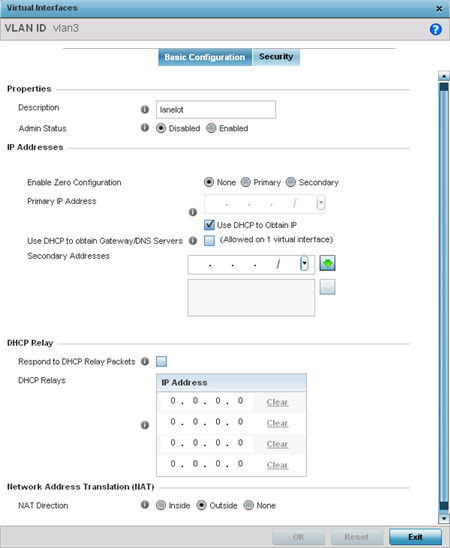To define a dynamic routing configuration:
Select Configuration > Profiles > Network.
Expand the Network menu to display its submenu options.
Expand the Network menu and select OSPF.
Select the Interface Settings tab.
Select the Add button to define a new set of virtual interface basic settings, or Edit to update the settings of an existing virtual interface configuration. The Basic Settings tab displays by default.

Within the Properties field, enter a 32 character maximum Description to help differentiate the virtual interface configuration used with this OSPF route. Enable/disable admin status privileges as needed. They're enabled by default.
Use the IP Addresses Area to set how route addresses are created for the virtual configuration.
Zero Configuration can be enabled and set as the Primary or Secondary means of providing IP addresses for the OSPF virtual route. Zero configuration (or zero config) is a wireless connection utility included with Microsoft Windows XP and later as a service dynamically selecting a network to connect based on a user's preferences and various default settings.
Select Use DHCP to Obtain IP to use the access point's DHCP server resource as the means of providing requested IP addresses to the OSPF route's virtual interface.
Select Use DHCP to Obtain Gateway/DNS Servers to learn default gateway, name servers and the domain name on just this interface. Once selected, specify an IP address and mask in dot decimal format.
Refer to the DHCP Relay field to set or override the DHCP relay server configuration used with the virtual interface:
|
Respond to DHCP Relay Packets |
Select the Respond to DHCP Relay Packets option to allow the onboard DHCP server to respond to relayed DHCP packets on this interface. This setting is disabled by default. |
|
DHCP Relay |
Provide IP addresses for DHCP server relay resources. The interface VLAN and gateway should have their IP addresses set. The interface VLAN and gateway interface should not have DHCP client or DHCP Server enabled. DHCP packets cannot be relayed to an onboard DHCP Server. The interface VLAN and gateway interface cannot be the same. When changing from a default DHCP address to a fixed IP address, set a static route first. This is critical when the controller or service platform is being accessed from a subnet not directly connected and the default route was set from DHCP. |
Define the NAT Direction as either Inside, Outside or None. Network Address Translation (NAT), is an Internet standard that enables a (LAN) to use IP addresses for internal traffic (inside) and a second set of addresses for external (outside) traffic.
Select OK to save the changes to the basic configuration. Select Reset to revert to the last saved configuration.